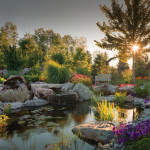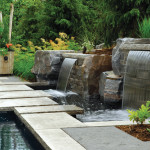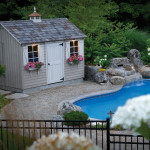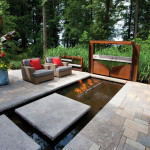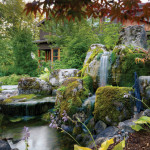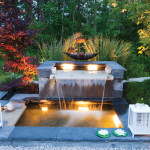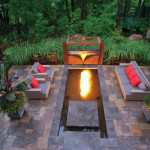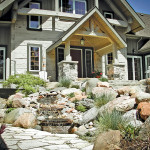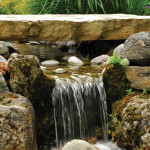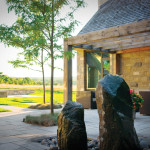From whimsical fountains to quiet pools, water features have made a comeback to become today’s hottest gardening trend
by Judy Ross
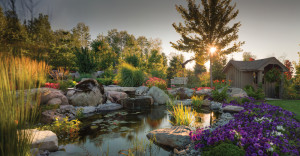
The relaxing patter of a waterfall, the calming trickle of stream water flowing over river rock, the gentle splash of a fountain … these are among the soothing sounds of water coming to gardens everywhere. Water in some form is the most requested feature when property owners hire a landscape architect.
“It changes the ambiance of a garden more than anything else you can do with your landscaping,” says Darren Bosch of The Landmark Group. “Water features create both sound and visual interest. We think of them as the art sculpture of a landscape project.”
Although water has been a staple of landscaping forever, this new approach of using water as an art feature has its roots in the contemporary gardens of California. It was there that landscape firms first began creating these wonderlands of water and light, from curtains of water descending down stone walls and ponds with fire dancing on the surface, to sculptural fountains with skyward-pointing beams of coloured light. At first it would seem that these extravagant creations might suit only a southern climate, but advances in technology and materials mean that water in many guises can be fitted into our four-season landscapes here in Southern Georgian Bay.
The first and most important consideration when adding a decorative water feature is the ‘style’ of your property. Ideally, your landscaping will match and complement the architecture of your home and the lay of the land. Do you want a natural, rustic-looking garden with streams and ponds that appear to have been there forever? Or is your property more formal and better suited to a man-made, more stylized water feature?
“Nothing looks more ridiculous than a natural rock waterfall in a flat, fenced subdivision lot,” according to Dustin Denis of Hayward Pool Products Canada, a company that sells the mechanical aspects of water features. “You can do many other things that will suit a garden like this, but so many people request something natural and it ends up looking like the waterfall comes out of a fence.”
Denis suggests that an alternative would be a lagoon-shaped pool with some laminar jets for drama. Laminars, the latest innovation in pool deck jets, look like clear unbroken arcs of water during the day. They can shoot as high as seven feet and create a dappling sound as they hit the water. At night, these same translucent water streams can be infused with coloured LED lights.
Some of the most intriguing advances in water features involve technology for controlling both sound and light throughout the garden. All systems can be fully automated and controlled from a tablet or smart phone. Water pumps can be speeded up to increase the water flow and therefore the sound of falling water. This is helpful when you want to drown out traffic noise.
Lighting can be similarly controlled and now comes in a wide array of options – from Disney-like extravaganzas to subtle mood changers. “Every water feature I sell includes seven fixed colours and five colour-changing shows,” says Denis, who sees more innovation in lighting than any other landscape feature.
With all this new technology, it follows that installation is becoming increasingly complex. As Mark Higginson of Natural Stonescapes in Meaford points out, “Timing is important because a water feature – whether it’s a pond, pool, fountain or waterfall – requires not only advance planning, but some pretty big equipment. If the house is in a new development it’s better to put in water features when there’s still access to bring big machines in. Once neighbouring houses are built on all sides, the access gets lost and it becomes more difficult. This is especially important with waterfront properties.”
A pond, or a small pool are the first thoughts that come to mind when considering adding water to a garden. Basically, there are two kinds: the natural-looking ones, often called koi ponds because of the fish that live in them. These give a wonderful sense of life to a garden, but they can be a lot of work. And in order for the fish to survive the winter, the pond must be deep enough not to freeze solid, at least 60 centimeters. The other pond style can be more shallow, doesn’t have fish, and is kept clear with chlorine so there’s no algae, no water plants and little maintenance. You can also get some wonderful reflective qualities with this kind of pond.
“All pond kits are standard; it’s what you put around it that makes the difference,” explains Higginson. “When we do a pond up on the Escarpment we line it with limestone because that’s what is naturally there. On the other hand, a pond by the water looks better with granite to match the natural environment of the shoreline. It’s all about keeping it indigenous.”
Even a postage-stamp-size property can benefit from a water feature. In one small garden a big hunk of limestone was core drilled and set in a bed of smooth river rock. A pump (set in a sort of underground bathtub) circulates water, which comes out the top and trickles down the sides of the rock. This gives both the sound and the look of a piece of sculpture without the deep water of a pond, which can be a consideration with small children. The happy owners found that birds also love this bubbling rock and come to drink from it.
When Darren Bosch of The Landmark Group was approached by the owners of a grand home on a wooded lot overlooking the Georgian Bay Club, he was asked to create a meandering stream and waterfalls in the backyard. “The owner wanted to hear the soothing sound of a babbling brook when lying in bed,” says Bosch, “and wanted the landscape to look as if it had been there for decades.”
The result, which took a team of three people three weeks to build, is a lush oasis with a series of waterfalls that tumble over rocks and flow into a stream, recycling constantly without a pond. To find the natural materials, the landscape team went on a scavenger hunt to get real moss-covered rocks and then kept them in the shade and watered them daily while the project was underway. Everything in this garden may look like it was created by nature, but it is far from it. The whole thing is set in an engineered concrete foundation, structured to be low-maintenance with all the lighting and water-flow systems remote-controlled.
As these gardens indicate, landscaping has come a long way from laying sod and putting some plant material in a backyard. “Design underpins everything we do now, and people are investing a lot of money in landscaping their properties,” says Bosch, “and now with water features like these they’re definitely taking it up a notch … or three!” ❧






